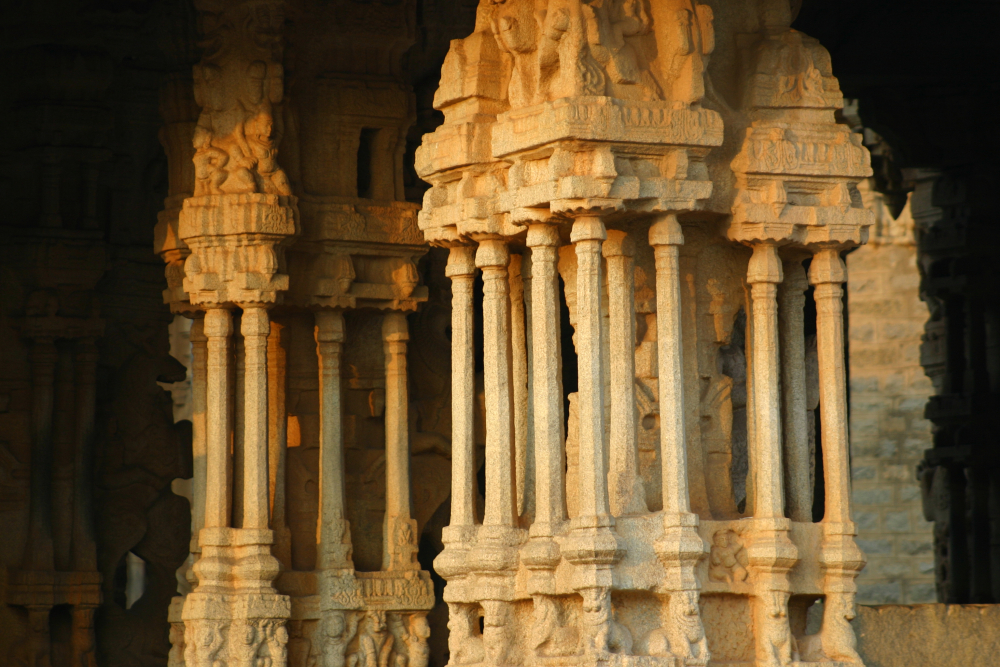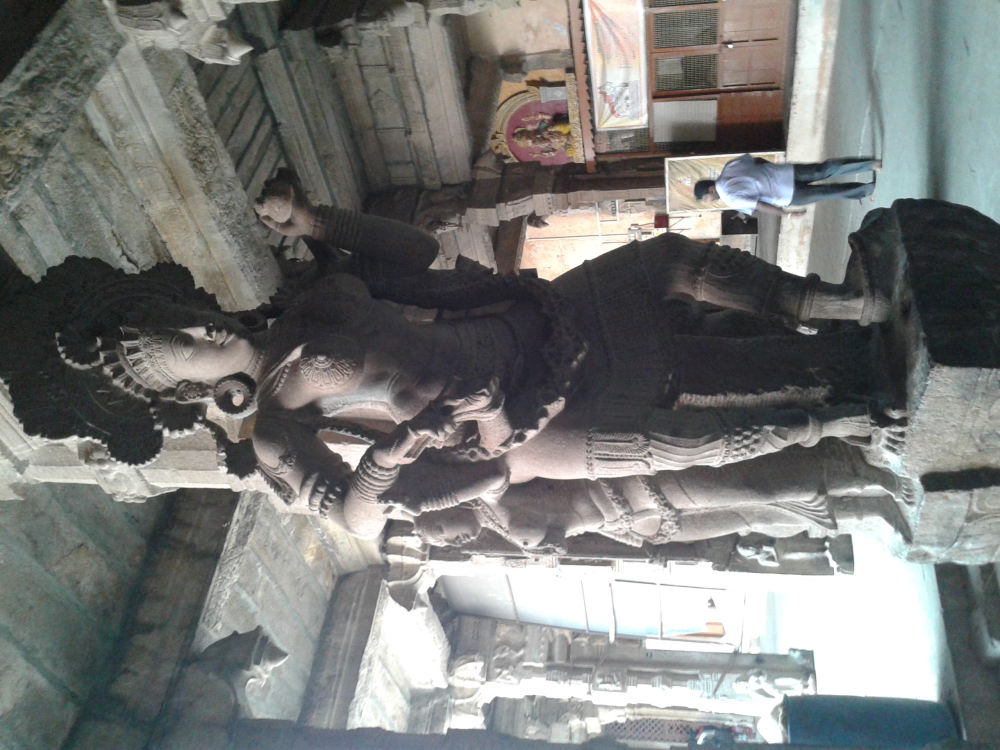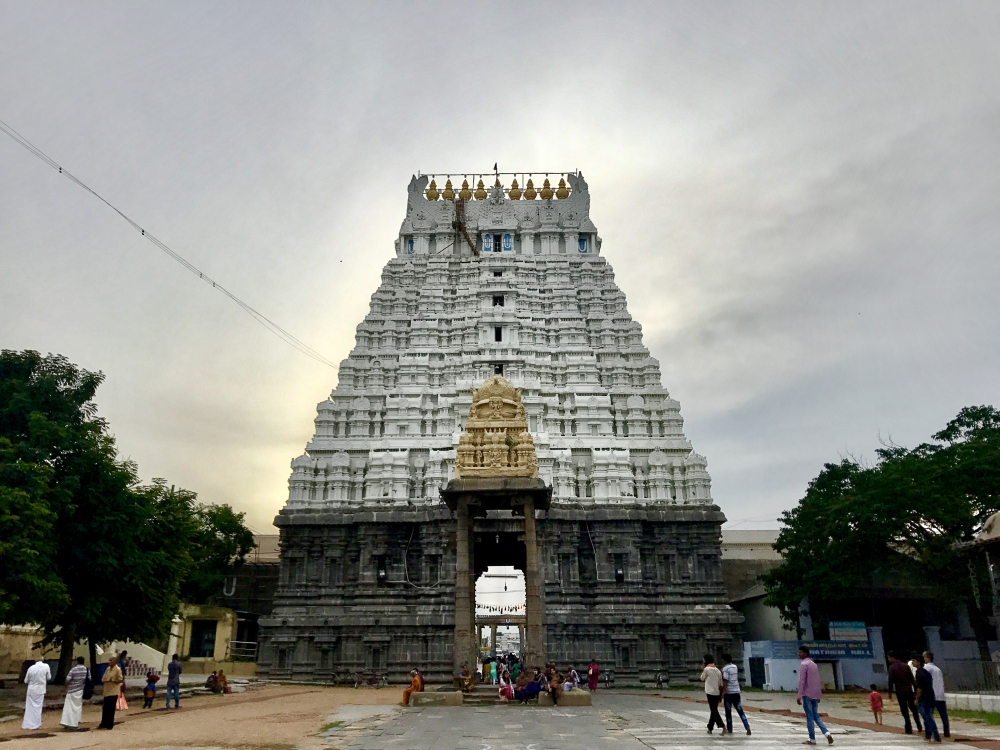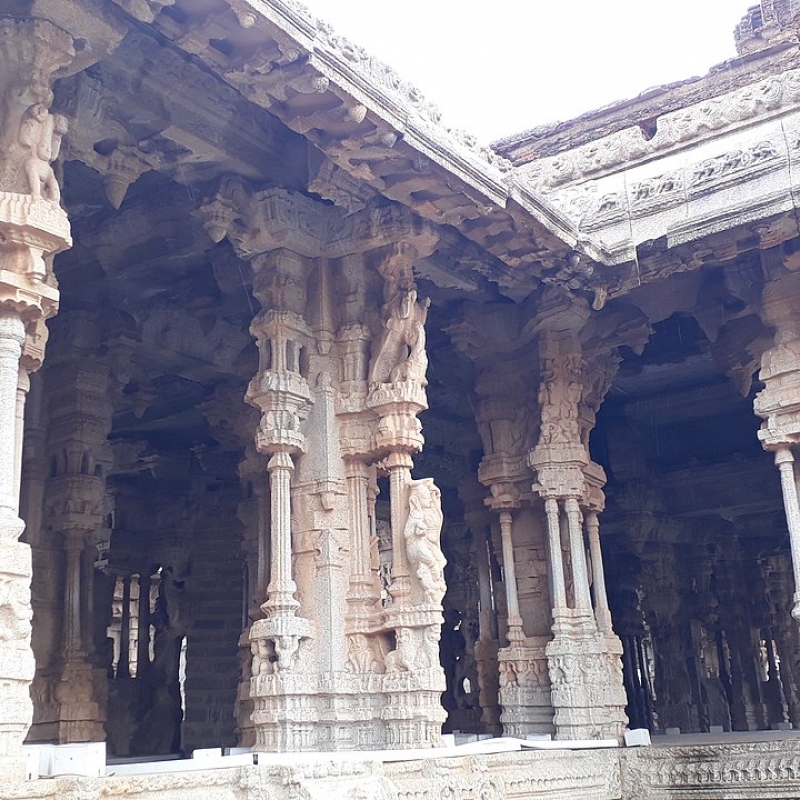An architectural feature seemingly unique to South Indian temples, mellifluous pillars that create music for the gods are found in a handful of temples in ‘Draviḍadeśa’. We explore these euphonious maṇḍapas, analysing the sui generis nature of this style of architecture that begs a more detailed scholarship (In pic: The musical pillars of the Vijaya Vittala Temple in Hampi; Photo courtesy: Naveeenkr/Wikimedia Commons)
India—often described as the ‘country of temples’—saw temple-building activity begin in the fifth century CE. It was only in the sixth–seventh centuries that a more pronounced idiom developed. In that, regional styles began taking shape. These styles had their own quirks. Gradually, these distinct architectural styles became a ‘formula’ that came to be associated with a region. Among several specificities that defined the temples of different regions, the musical pillars became idiosyncratic to the temples of Deccan and, especially, in the state of Tamil Nadu. In other regions, for instance, Odisha came to be associated with the Rekhā deul-style, the Śekhari-style with the temples of Madhya Pradesh, the Phaṁsanā-style with the temples of Kashmir, the Karnāṭa-Draviḍa style with the temples of Karnataka and Andhra and, Draviḍian-style with the temples of Tamil Nadu.
What are Musical Pillars?
They are a group of stone shafts that produce musical notes of varying frequencies when tapped with a finger or wooden mallet.[1] These pillars are of two kinds: 1) Beating/Tapping pillars and 2) Blowing pillars. While the first kind produces sound when tapped, the second kind, which is most likely hollow, works like a wind instrument.[2] The tapping pillars are further classified into three categories: Shruti, Gana and Laya. It is suggested that shruti produces swaras, gana produces classical ragas, and laya produces taal when tapped.[3]
Also read | Temple Architecture of the Calukyas of Badami
If you are wondering how to identify these pillars, it is not all that onerous. Musical pillars are narrow yet firm in form, clamped at the ends, drawn out of a single block of stone,[4] bereft of carving[5]. According to scholars, they are usually arranged in groups (between 3 and 56)[6] around a central pillar which supports the roof of the structure. The central pillar could vary in height, but the cluster pillars are of the same height with varying girth and shape.[7]

National award-winning scientist H.V. Modak referred to these pillars as ‘Stone Pianos’, assigning them to the Vijayanagar period (fourteenth–sixteenth centuries),[8] while scholars M.G. Prasad and B. Rajavel believe they might have begun surfacing as early as the eighth century—the Tirunelveli Nellaiappar temple in Tamil Nadu—but mostly during the fourteenth–sixteenth centuries.[9]
So why was there an influx of musical pillars for 200 years?
It is said that these pillars were tapped or blown like musical instruments to accompany chants and devotional performances in the temples.[10] The possible reason for their prevalence in the ‘medieval’ temples of the South could be the multiple halls (maṇḍapa)—sculpture gallery, musical pillar hall, performance hall, etc.—which became an intrinsic part of massive temple complexes, a layout which out-shadowed the concept of single maṇḍapa.
Related | Who are the 16 Surasundaris on Indian Temples?
What influenced the peculiar acoustics was either the rock type or the clustered arrangement of the columns. According to the Śhilpa Śhāstras, rocks are masculine, feminine and neuter based on their sound and colour.[11] The male rock produces the tinkle of bronze bells, the female of bass and the neuter produces a dull sound. It is possible that the pillars are musical because they are carved out of rocks with acoustic properties—diabase rocks (black granite)[12] or rocks rich in silica and metallic ore.[13] Such rocks are called singing[14] or lithophonic rocks.
However, in an experiment carried out at various temples with musical pillars, Modak realised that the arrangement of the clustered pillars in the wall-less maṇḍapas also played a role in lending sound to the pillars.[15] In a cluster, when a pillar is tapped, other pillars with same frequency vibrate with resonance making the group a musical instrument, fit to accompany hymns and performances composed in three–five notes. It is interesting to note that all the shafts from the cluster do not emit musical notes, only the ones on the outside were tailored to produce music.

Where to Find Them?
Temples with musical pillars are spread across Tamil Nadu, Andhra Pradesh, Karnataka and Kerala, with Tamil Nadu topping the chart. Look out for the popular Hampi, Vijaya Vitthala temple in Karnataka; Madhurai Meenakshi Amman temple, Tirunelveli Nellaiyappar temple, Suchindram Thanumalayam temple, Kanchipuram Varadharaja Perumal temple in Tamil Nadu; Tirupati Venkateshvara Swamy temple, Lepakshi Veerabhadra temple in Andhra Pradesh; Thiruvananthapuram Sri Padmanabhaswamy temple in Kerala, to list a few.
Also see | Door Frames of Nagara Temples
Not known to many, the mahāmaṇḍapa (main hall) of Hampi’s Vitthala temple boasts a cluster of 56 such pillars; 40 of them forming an aisle, the remaining forming a rectangular cluster in the centre.[16] The tall pillars of the ‘musical hall’ are carved with beautiful ends. It is said that the granite monoliths produce sounds of seven notes, percussion instruments such as tabla, veena, mridanga, damaru, ghatam, and bells and conch-shells once struck with one’s hands.[17]

Several temples in the South are executed with architectural elements such as pillars, stairs and icons that produce music. One such temple is the sixteenth-century Kanchipuram Varadharaja Perumal. This temple is well-known for its 100-pillared hall, a sculpture gallery depicting scenes from Ramayana and Mahabharata. It has been suggested that the sculptures of this gallery produce sounds of metals such as gold, copper and silver; tambura, an Indian musical instrument; and chains[18] when tapped,[19] a relatively unknown fact. Do not miss the musical sculptured pillars and monolithic chains with movable links suspending from the eaves, the next time you visit the Varadaraja Perumal temple.
Also read | The Chola temples
Often, as camera-wielding tourists, we don’t notice other elements that architecture has to offer. Many, like these musical pillars, haven’t been explored as much either. Interestingly, the feature seems to be unique to a handful of these South Indian temples, which make them an even more prized aspect of Indian architecture, and definitely worth checking out in person.
This article was also published on The Week.
Notes
[1] H.V. Modak, ‘Musical Curiosities in the Temples of South India,’ Impact of Science on Society XXXV, no. ½ (1985): 33–34. Accessed September 21, 2020. https://www.sahapedia.org/sites/default/files/2019-03/Musical%20Curiosities%20in%20the%20Temples%20of%20South%20India%20-%20H.%20V.%20Modak.pdf.
[2] M.G. Prasad and B. Rajavel, ‘Musical Pillars and Singing Rocks,’ (Noise and Vibration Control Laboratory, Department of Mechanical Engineering, Stevens Institute of Technology, Hoboken, New Jersey). Accessed September 21, 2020. https://www.academia.edu/6904792/MUSICAL_PILLARS_AND_SINGING_ROCKS.
[3] Ibid.
[4] Modak, ‘Musical Curiosities in the Temples of South India,’ 34; Prasad and Rajavel, ‘Musical Pillars and Singing Rocks.’
[5] Prasad and Rajavel, ‘Musical Pillars and Singing Rocks.’
[6] Modak, ‘Musical Curiosities in the Temples of South India,’ 34.
[7] Modak, ‘Musical Curiosities in the Temples of South India,’ 34; J. V. Siva Prasanna Kumar, ‘Tamil Nadu: Stone Turn Melodious Musical Instruments,’ Deccan Chronicle, August 5, 2018. Accessed September 21, 2020. https://www.deccanchronicle.com/nation/current-affairs/050818/tamil-nadu-stones-turn-melodious-musical-instruments.html
[8] Modak, ‘Musical Curiosities in the Temples of South India,’ 32.
[9] Prasad and Rajavel, ‘Musical Pillars and Singing Rocks.’
[10] Modak, ‘Musical Curiosities in the Temples of South India,’ 38–39.; Prasad and Rajavel, ‘Musical Pillars and Singing Rocks.’
[11] J.V. Siva Prasanna Kumar, ‘Tamil Nadu: Stone Turn Melodious Musical Instruments,’ Deccan Chronicle, August 5, 2018. Accessed September 21, 2020. https://www.deccanchronicle.com/nation/current-affairs/050818/tamil-nadu-stones-turn-melodious-musical-instruments.html.
[12] Prasad and Rajavel, ‘Musical Pillars and Singing Rocks.’
[13] Sudha Raja, ‘Music from Pillars,’ The Hindu, June 4, 2015. Accessed September 21, 2020. https://www.thehindu.com/features/kids/music-from-the-pillars/article7282158.ece#:~:text=Rasa%20read%20out%2C%20%E2%80%9CThe%20musical,when%20struck%20with%20a%20thumb.
[14] Prasad and Rajavel, ‘Musical Pillars and Singing Rocks.’
[15] Modak, ‘Musical Curiosities in the Temples of South India,’ 38–39.
[16] Prasad and Rajavel, ‘Musical Pillars and Singing Rocks.’
[17] Ibid.
[18] ‘Kanchipuram Temple Varadharaja Perumal Temple,’ Food and Travel, July 31, 2016. Accessed September 23, 2020. https://www.youtube.com/watch?v=0rNaVHASyTA&feature=youtu.be.
[19] A.R. Sharif, ‘The Hall of 100 wonders,’ in Indiana: The Book of Indian Wonders (Mumbai: Turtle Books, 2010), 117.












